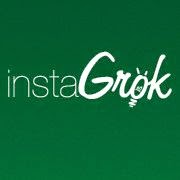Instagrok is a research tool that allows students to search trusted websites and provides search results in a visual format. Students can view the websites within Instagrok and star the ones that fit their topic. This web tool also provides a work space for students to begin paraphrasing and analyzing the sources they have chosen.
Students do not need an account to begin using Instagrok, but signing in allows a student to save her work from session to session. If a student already has a Google account, the student can sign in using this account. The opening page has a search box where students can enter a question or the topic they are researching. The results are presented in a visual web of terms and ideas related to their topic. Students can click on any part of the web to begin exploring websites which open up within Instagrok.
If a website provides information that the student is looking for, the student can press the green pin to save website for view later. Instagrok also helps students learn how to evaluate a website. Below each webpage is a "Is this site credible?" button. When students click on the button, they are taken to a list of questions provided by Easybib that help them evaluate the website. The teacher can then choose which questions they want their students to answer about a resource.
All of the websites students pin are saved to a journal. Students can then begin paraphrasing the material to help write the report. Since students have signed in using Google or created an account, the information is saved. This allows students to easily access their information later.




